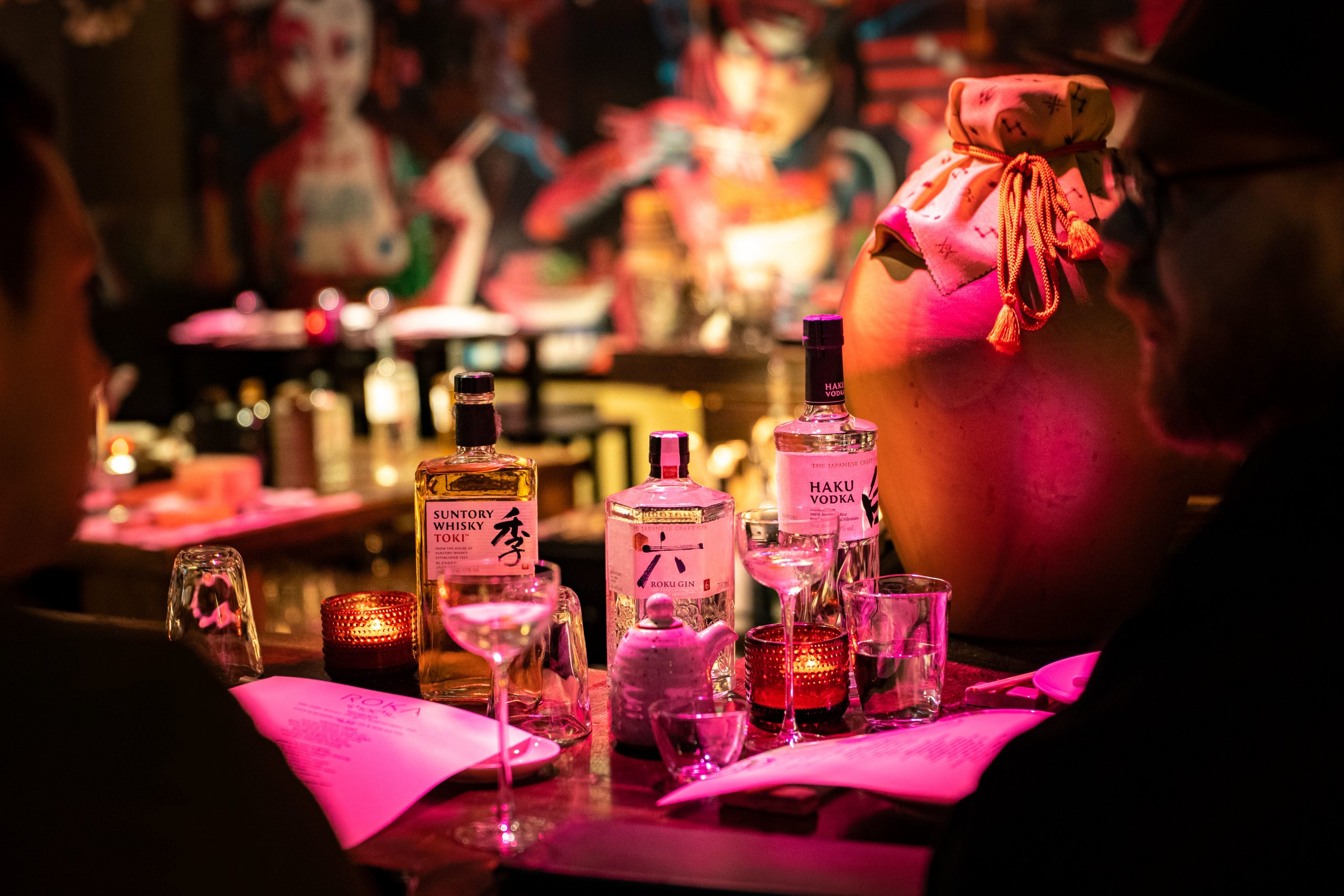This year some of the UK’s top bartenders have been learning about Japanese spirits and culinary culture thanks to House of Suntory’s fantastic DOJO programme. In this interview we speak to one of the programme’s Master instructors – award winning Ikebana designer Keiko Smith.

Keiko Smith grew up surrounded by the temple and shrine gardens of Kyoto. This immersion in nature sparked a passion for the environment, flowers, and trees which led to the study of the Japanese art of floral design, or Ikenobō Ikebana, at age 16. Keiko’s studies continued in later life, culminating in a Professorship of Ikebana and, in 2001, being member of the team that won ‘Gold’ and ‘Best Garden’ awards at the Chelsea Flower show. As such Keiko is the perfect person to teach the lucky DOJO students about the art and philosophy of Japanese flower arranging.
BLUK: Some readers may be unfamiliar with the term Ikebana. Could you tell us how it differs from other forms of flower arranging, and the philosophy behind the practice?
KS: Ikebana, often translated as ‘giving life to flowers’, is also known as ‘Kado’. Which, in a similar vein, means ‘way of flowers.’ In essence it is the art of arranging flowers, branches, leaves and stems to express feelings as your own creation. Putting these into a vase to harmonise and balance the materials. However, as an art form, Ikebana goes far beyond formal flower arrangement and aesthetics. It is informed by artisanship (Monozukuri) and reverence for seasonality inherent in Japanese culture.
Interestingly, concepts such as these draw interesting parallels in the development of Roku – a gin crafted from a balance of six unique Japanese botanicals and eight traditional gin botanicals but founded on harmony with nature.
A place in which my ‘Ikebana and Aesthetics’ workshop aims to offer a deeper understanding of the cultural relevance of how Roku is made. But also, how applying some of the thinking of Ikebana to the art of garnishing can help better reflect the craftmanship behind the gin. Considering interrelated concepts such as form, season, balance, minimalism, and harmony, especially as Ikebana tells us that botanicals are at their most intense at particular times of the year. So, for instance, with regard to Roku, each of the six different botanicals are harvested over Japan’s four seasons for maximum flavour intensity. A unique process that both myself and the DOJO participants can learn a lot.
BLUK: When you are about to create a new arrangement, do you begin by selecting flowers and plants, or do you form a concept first, and then select the flowers which best express that concept?
KS: I always begin with concept first. It is essential to know where your flowers will be, who they are for and the occasion behind them. All this information helps create the guidance needed to visualise and conceptualise the project ahead of you.
BLUK: The DOJO students you taught are bartenders accustomed to thinking in terms of flavour and texture. How do you think the colours and aroma of flowers presented with a cocktail affect the way a guest will experience it?
KS: Fundamentally, our senses are interrelated and can significantly impact the overall experience. DOJO offers an immersion into unique ways in which bartenders can harness this. Thinking about how they might use all five senses to create and subvert associations with colours, textures, aromas and flavours to enhance the overall experience. Applying the craft of Ikebana in this way, choosing a particular flower for its colour and aroma can have instant and interesting effects. Eliciting associations, unearthing memories or transporting people in their minds. DOJO explores these aspects in unique ways to help provide an experience that endures beyond just the cocktail.
BLUK: Your DOJO session looked at adapting Ikebana principles to create cocktail garnishes. Do you think edible flowers have a role to play in this, and if so, what are some examples of edible flowers which work well both aesthetically and as a flavour ingredient?
KS: I’ve been working with the DOJO students on the importance of seasonal variations. Just like flowers, people’s palettes and preferences change with the seasons. Using the pillars of Ikebana to better understand colour coordination, texture, balance, harmony and minimalism, we can emphasise the importance of catering to different emotions and environments throughout the year. The presentation can be just as important as taste regarding cocktails, especially as we’ve seen how creative bartenders have become with their serves.
BLUK: I looked at some Ikebana photos while researching for this interview, and was struck by how delicate the arrangements are. Is negative space an important part of the Ikebana concept?
KS: Absolutely. Within the craft of Ikebana, it is most important to have a space to create natural beauty. Often, simplicity and minimalism can prove just as effective as precision and complexity.
BLUK: Many bars evolve their cocktail menu to reflect seasonal ingredients as the year progresses. Is the same true of Ikebana, and what types of flowers become available during the different seasons in the UK?
KS: Absolutely. For any bartender, while it is essential to offer several staples, people are naturally curious and constantly looking to try out different things. So, paying attention to the latest trends is key to ensuring customers a new, unique experience. The same applies to Ikebana, ensuring we, as masters of our craft, reflect the changing seasons and via DOJO, an understanding of this seasonal variation draws parallels between the drinks, the garnish and the mood and space around them.
For instance, in Japan, spring offers us cherry blossom, summer the sunflower, autumn Japanese maple, and winter for the likes of pine, plum and bun boo. Bringing this to Japanese spirits offers drinkers of Roku gin a voyage through the four seasons, using the best ingredients harvested from areas across Japan.
The DOJO Ikebana and Aesthetics workshops help offer this knowledge and consider how garnishes and presentation can use and elevate signature seasonal flavours.
BLUK: Can you tell us your favourite spirit, and describe the Ikebana garnish you would create for it?
KS: Naturally, Roku Gin is a personal favourite of mine. Both the subtle complexity of flavour and the unique story behind the craft. Roku Gin, matcha, ginger, asparagus, and lemon, garnished with red or pink rose petals, is my ultimate combination.
BLUK: What skill or technique were you most excited to share with the DOJO students?
KS: The concept of finding balance. And creating cocktails that reflect the natural beauty deep-rooted in the practice of Ikebana.
All the elements we bring into the Ikebana craft draw parallels with the artistry of a highly skilled bartender. From how a cocktail looks or how it’s displayed on the menu or showcased on a bar, it can be just as important to the person ordering as its ingredients and taste. DOJO offers a unique opportunity to explore this aspect of the bartender’s craft.
BLUK: If our readers would like to learn more about Ikebana, can you recommend some further reading or learning resources?
KS: I have a YouTube channel that explains Ikebana for beginners and teaches the lessons and practices that got me to where I am today. You can also watch the Ikebana demonstration from the Aesthetics DOJO masterclass we held back in July.
For more information on DOJO, head over to https://www.suntorydojo.com/home/.


